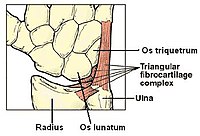
Photo from wikipedia
Isolated proximal radioulnar joint instability is an uncommon and often challenging problem that may manifest as recurrent instability of the proximal aspect of the radius, usually during forearm pronation and… Click to show full abstract
Isolated proximal radioulnar joint instability is an uncommon and often challenging problem that may manifest as recurrent instability of the proximal aspect of the radius, usually during forearm pronation and supination. Instability is due to deficiency of the stabilizing structures around the proximal aspect of the radius, and biomechanical studies have highlighted the importance of the annular ligament and the interosseous membrane in both transverse and longitudinal plane stability. Reconstruction of the stabilizing structures around the radial head often is indicated in cases of recurrent instability and includes joint-preserving procedures such as annular ligament reconstruction, proximal ulnar osteotomy, and interosseous membrane reconstruction. Rarely, salvage procedures such as interpositional arthroplasty or 1-bone forearm reconstruction are necessary. A thorough understanding of the anatomic structures that stabilize the proximal aspect of the radius and the complexities of forearm biomechanics is required in order to successfully diagnose and manage this condition.
Journal Title: JBJS reviews
Year Published: 2020
Link to full text (if available)
Share on Social Media: Sign Up to like & get
recommendations!